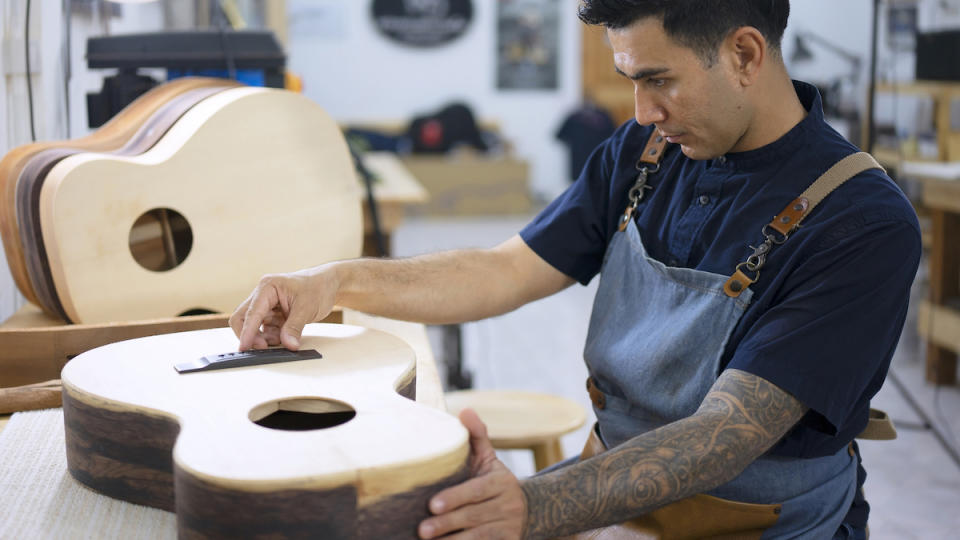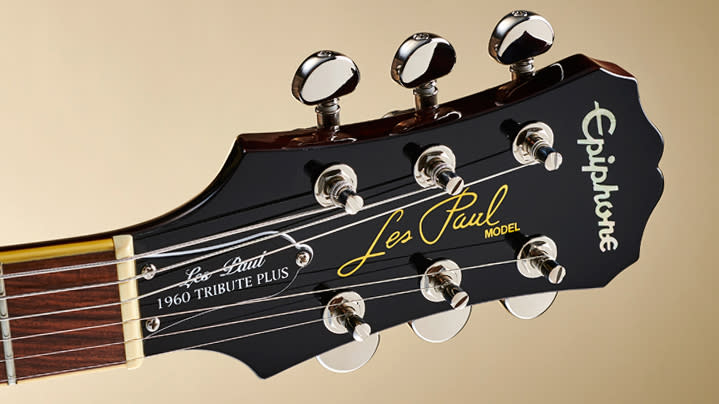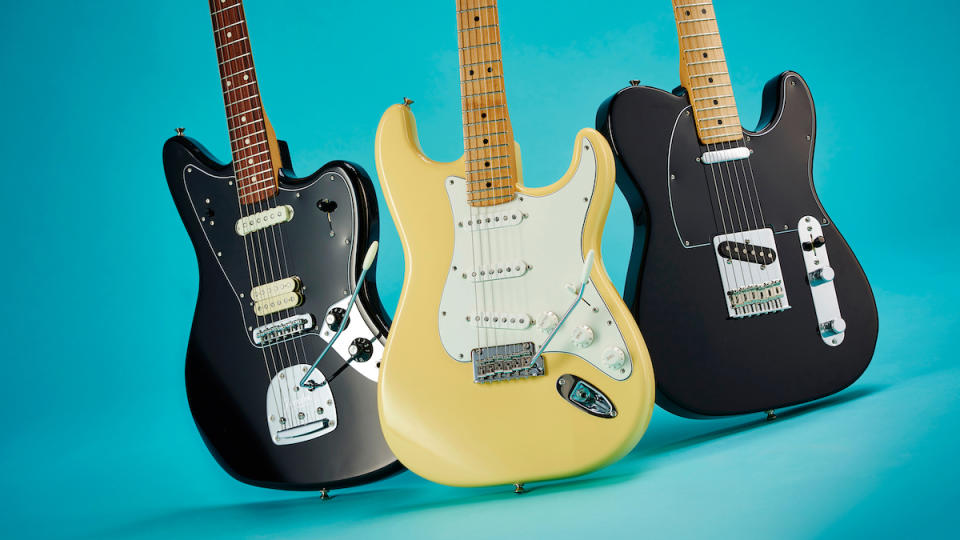Is there a benefit to buying a more expensive guitar as your first?

It’s an age-old conundrum. Do you heed the voice of reason in your head, or give in to those ceaseless impassioned cries from your heart?
On the surface, choosing a cheap instrument over a more expensive model is the most sensible route into guitar ownership. You may decide early on that playing the guitar isn’t for you after all, so you’ll want to cut your losses.
Then there’s imposter syndrome, an anxiousness that, as a beginner, you’re not deserving enough to own a decent instrument. It will be wasted on you.
But on the other hand, your inspiration for playing the guitar is probably rooted in the iconic instruments you’ve seen planted in the hands of your favorite artists. The Fender Strat and Tele, Gibson’s Les Paul or ES 335, the Martin D28. Surely, these are the instruments for you, so why settle for less? Buy once, buy well, right?
For many of us, the best solution will lie somewhere between these two extremes. If you’re well on your way to making your second billion then heck, spend whatever you want, knock yourself out. Or, if money is tight, take comfort from the fact that you can buy a very good beginner electric guitar for less than a couple of hundred bucks.
That said, stretching your budget a little further can give you some impressive gains, especially if you’re an acoustic player. Read on to discover when it’s worth spending that little bit more.
1. The joy of ownership
+ Your dream guitar may cost a little more
+ Mid-level acoustics are noticeably better than entry-level
+ It will inspire you to keep playing
- Some entry-level electrics are excellent. Why pay more?
- Expensive guitars are wasted on young children who show no interest in playing
Is a high-end guitar wasted on a beginner? No. I’m a firm believer that adult acoustic players should buy the very best instrument they can afford. If that’s a beginner instrument, bought on a budget, then great. However, if you can afford more, then spend it. You’ll end up learning on a guitar that’s both easier to play and more pleasurable to listen to. An instrument that’s easy to fall in love with and hard to blame for your playing inadequacies.
Buying advice is less clear cut for electric guitars because their lower action makes them more comfortable to play than acoustics for beginners. They’re easier to adjust if the set-up isn’t quite right too. Additionally, unlike acoustics, solid-body electrics such as Strats and Teles don’t need an expertly crafted, resonant body to generate tone. So, provided the neck is good, entry-level electric guitars from brands such as Squier and Epiphone can sound very close to their mid-level Fender and Gibson stablemates. However, there’s something very comforting about owning a guitar that’s that little bit more special.

2. Solid wood vs laminate vs veneer
+ Solid wood is more resonant than laminate of the same thickness
+ Solid wood acoustics have a more complex tone
+ Guitars with solid tops aren't too expensive
- Laminate acoustics can still sound great
- Laminate is stronger, and more resistant to temperature change
- Premium brands like Martin make some laminate guitars
Many guitarists consider a solid wood top to be a mark of quality for an acoustic guitar, bettered only if the entire instrument is constructed from thin sheets of solid tonewood. The alternative is laminate, a sandwich of separate layers of material bonded together with resin.
Solid wood is preferable for tone hounds because it vibrates more freely
Laminates, of which there are several different kinds, are popular with guitar brands because they’re inexpensive, consistent, readily available, strong, resistant to temperature change and look just as good as solid wood. However, solid wood is preferable for tone hounds because it vibrates more freely, resulting in a guitar that’s louder and more resonant, with a sound characterized by additional complexity.
Acoustic guitars at the budget end of the market are likely to have bodies made completely from laminate, but spend a little more and you’ll find plenty of brands boasting instruments with solid tops. There’s rarely mention of the rest of the guitar body at this price point because the top is the instrument’s soundboard, which makes it a more critical component than the back and sides. Fork out quite a lot more and you’ll be the proud owner of an all-solid guitar.
It's worth recognizing that laminates aren’t all bad. Prestigious brand C F Martin makes many of its lower-end guitars from High Pressure Laminate (HPL), a material composed of bonded sheets of wood fiber and paper. Many archtop guitars, including Gibson’s legendary, and somewhat pricey, 335 line, are also made from laminate because it’s an easy material to press into shape.
Low-cost electric guitars with ornately flamed tops that look like a million dollars, are probably made from a cheap material, such as medium density fibreboard (MDF) or plywood, that’s been covered in a very thin sheet of wood called a veneer. These can look great and may sound acceptable, but the finish is prone to chipping easily.
Of course, Gibson’s expensive Les Paul model usually features a maple cap, one that’s often elaborately flamed or features a gorgeous burst of color. Don’t worry, this cap is way too thick to be a veneer, its true purpose is to bring balance to the tone of the guitar’s heavy mahogany body. The stunning appearance is just the icing on the cake.
3. Solid body electrics built from multiple pieces of material
+ Fewer pieces of body material may be more resonant
+ It may help your guitar’s natural sustain
+ Transparent finishes look better with fewer visible pieces
- Multiple pieces of material may look ugly, but that’s what paint’s for
- Multi-piece bodies may be stronger
Top-of-the-line solid body guitars, such as a Fender Strat or Tele will be made from as few pieces of wood as possible. Perhaps two or three, maybe just the one. Cheaper guitars are commonly made by bonding multiple chunks – as many as six or seven – of wood together.
Will this affect your tone? The jury’s still out on this one. Some guitarists maintain that bodies made from many separate pieces of wood resonate better. Others claim this is nonsense and will actively seek out single-piece bodies instead.
Frankly, if the guitar you’re choosing has a painted body, then aesthetically it’s of little consequence. On the other hand, if you favor a natural look, or a semi-opaque burst, then the separate pieces of wood can interrupt the visual flow of the finish.
4. The importance of intonation
+ Well-made guitars are more likely to intonate accurately
+ Intonation issues with cheap acoustics can be hard to fix
- Electric guitars, even cheaper models, can be adjusted to intonate well
Electronic guitar tuners and smartphone apps make light work of tuning the open strings of your guitar. Many amps are equipped with tuners too, as are pretty much all DAWs.
However, getting notes to ring out in tune up and down the fretboard on a cheaply built guitar can have you pulling your hair out in frustration. The issue is intonation, or more accurately, the lack of it.
Intonation is the accuracy of pitch across the fretboard, so a poorly intonated guitar will sound horribly out of tune as you fret different notes and their intervals, most noticeably octaves. A good way to test for this is to tune the guitar up and then sound the strings at the twelfth fret, which should be exactly an octave up (most tuners can be used to check for this). Unfortunately, it’s a condition that can be difficult if not impossible to rectify, especially when it afflicts a badly made acoustic.
If you’re lucky, cheap, poorly made strings can be the culprit, so replacing them may cure the issue. In fact, replacing the strings on any cheap guitar is an excellent, inexpensive upgrade.
Another relatively easy fix on electric guitars is to adjust the bridge saddles with a screwdriver, shortening the strings if they’re a bit flat and lengthening them if they’re a little sharp. It’s also possible to adjust the bridge on an acoustic, but it’s skilled work that’s likely to cost.
Finally, it could be that the action is way too high, the neck relief is all over the shop or the frets have been spaced by a luthier who left their glasses on the bus. All of these issues are fixable but they’re rarely worth the expense on a cheap guitar.

5. Better tuners
+ Quality tuners make a guitar easier to tune
+ A guitar with great tuners will stay in tune longer
- In most cases, tuners are easily upgraded
Poor quality machine heads, popularly known as tuners, are the bane of every guitarist's life. Unsurprisingly, if a tuner isn’t doing its job correctly then your guitar’s going to slip out of tune at every opportunity.
Tuners are complex pieces of kit that need to be manufactured to within precise tolerances. There are a few different kinds, with most consisting of a capstan that holds the string, mounted in the center of a pinion gear. Linked to this is a short metal shaft with a tuning button at one end and a worm gear at the other. As you turn the button, the worm gear engages the pinion gear, rotating the capstan and winding, or loosening, the string. Many acoustic guitars have exposed, open tuners for a retro look, while electric guitars tend to be specced with permanently encased gears, which are usually lubricated for life.
Any play in the system will make a guitar devilishly hard to tune. What’s more, it’s unlikely to stay in tune for any useful amount of time. Tuning a guitar is enough of a pain as it is. Don’t make your life worse by buying a guitar with awful tuners.
6. Better strings
+ Bad quality strings sound awful
+ Cheap strings rarely stay in tune, or intonate well
- Strings are a consumable that are easily replaced
Buy a cheap guitar and you’ll almost certainly end up with nasty strings. Not only will they suck every ounce of glorious tone from your instrument, they’re also likely to be a nightmare to tune and can plague your guitar with intonation issues (see above). Do yourself a favor, rip them off at the earliest opportunity and replace them.
Bricks ’n’ mortar guitar stores are wonderful sources of expert advice, making them reassuring places to purchase a first guitar. However, they’ll invariably let anyone play their stock, even the high-end kit, which can result in tired-sounding strings. Don’t be shy to ask for them to be changed.

7. Action replay
+ A great action makes any guitar a dream to play
+ Action is rarely poor on decent quality instruments
+ A high action on an acoustic can be frustrating to fix
- Inexpensive electric guitars can have their action adjusted
Acoustic guitars made hurriedly in a factory by careless workers are unlikely to go through any meaningful QC check. These instruments can be fraught with problems, with the most common, and most serious, being a crazy high or low action. If you’re not that familiar with guitar terminology, a guitar’s action is the height at which the strings sit above the frets.
If you’ve got tender newbie fingers, you’ll find trying to fret a note with strings as fine as cheese wire difficult enough, without having to wrestle with a high action
Too low and the guitar will exhibit fret buzz. Too high, which is the more likely scenario, and you’ll suffer tuning issues, intonation problems and, worst of all, a painful playing experience. If you’ve got tender newbie fingers, you’ll find trying to fret a note with strings as fine as cheese wire difficult enough, without having to wrestle with a high action. The spot with most potential for pain is behind the first fret, which is where beginners spend much of their time.
There are multiple reasons why a guitar’s action can be intolerably high or low. A badly cut nut, a poorly adjusted saddle, a wonky fretboard or awful neck relief are just a few of the culprits.
There are a couple of caveats. If you’re a beginner, or an electric player trying an acoustic for the first time, you’ll likely find the action feels a bit high anyway. However, if it’s around 2.5-2.75mm at the 12th fret then it’s probably in the right ballpark. Trust us, you’ll soon get used to it.
Action issues are less prevalent with electric guitars because they are so much easier to adjust. They can tolerate a lower action too, which makes them a more attractive instrument for beginners.
8. Pups, pots and switches
+ Spending more guarantees improved tone
+ An onboard pickup and preamp are a blessing for the gigging acoustic guitarist
+ Better switches and jacks are quieter and more reliable
- Electronics can be upgraded in the future
- Acoustic guitars can be retrofit with pickups and preamps
You may have noticed that guitarists love accessories and upgrades – pretty much anything that will customize and personalize their playing experience.
An entry-level acoustic probably won’t come equipped with a pickup and preamp system. No matter, if your ambition is to play live you can quite easily add these upgrades later from brands such as Fishman and LR Baggs. They, and others, sell a huge range of aftermarket soundhole pickups, piezo pickups and guitar mics, many of which you can install yourself, provided you’re happy taking a drill to your six-string.
Mid-level acoustics often come with electronics pre-installed, which may be enough to justify their additional purchase price. Conversely, high-end acoustics often don’t feature any onboard electronics, or they remain optional, probably because super expensive guitars are rarely gigged or tend to be miked up for a more authentic sound.
Electric guitars are, of course, always packed with pickups, pots and switches, which have a huge influence on an instrument’s tone. The more you spend the more promise these components hold. Budget electric guitars, for example, will feature mass-produced machine-wound pickups, while high-end custom instruments can be blessed with boutique, hand-wound beauties made with vintage-correct materials.
Fortunately, the market is swarming with aftermarket components, both from the major guitar brands such as Fender and aftermarket specialists like Seymour Duncan and Bare Knuckle Pickups. Compatibility issues are something to be aware of, but there’s nothing to stop you buying an entry-level Squier Strat and swapping out the electronics for something much more desirable.

9. Resale value
+ Premier brands tend to hold their value better
+ Sought-after guitars can bring a decent return
- If the market slides, you’ll lose less on a cheaper guitar
Resale is a tricky one. Like most things, the vast majority of new guitars will fall considerably in value as soon as you buy them. A cheap guitar won’t have far to fall, but then it will never be worth much, however long you keep it.
Mid-market, standard-issue guitars can hold their value quite well, but they’re rarely investment vehicles! For example, eBay and Reverb are swamped with 20-year-old Fender USA Strats. Those in good condition will sell for about the same as their original RRP, which is a significant loss once inflation is accounted for.
Depending on spec, condition and provenance, high-end guitars can sell for a decent profit, especially if they’re associated with a famous artist. Brand is important, a high-end Taylor or Martin will always be easier to sell on than a high-end Yamaha, even if the Yammie is a better guitar.
Unless you really know what you are doing and can afford to take the occasional hit, it’s best to think of guitar ownership in terms of an investment in pleasure rather than a pension fund.
Conclusion
There’s no getting away from it. The more you spend on a guitar the easier it will be on the eye and the more comfortable it will be to play. Not only will it sound better but you’re more likely to find a tone that forges a personal connection. That sound that’s been swimming around in your head for years? Well, it can finally be realized.
Entry-level guitars sound a bit generic because they’re built from commonplace materials and, where applicable, unexceptional electronics. While a Chinese-sourced Squier Sonic Strat will obviously sound different to an Epiphone Les Paul Studio E1, it won’t have much character beyond sounding suitably Fenderish. Similarly, the Epi will radiate that Gibson vibe, but little more. It’s the same with acoustic guitars, a Yamaha F310 is a well-built budget instrument that sounds good but not epic.
As an example, spend just a little more on that Squier and you will land yourself an Affinity model, bringing more pickup options, jumbo frets and a better-quality bridge. Increase your spend by a few hundred $/£ and you’re immediately in Fender Made in Mexico territory, eyeing up its Player series. A proper Fender logo is slapped on the headstock, materials and components are improved, and more options are introduced, including artist specials like the Robert Cray Standard Stratocaster. The progression in quality continues through Fender’s various USA-manufactured lines, right up to its Custom Shop guitars that can be built to your exact specifications. Each step of the way, your money is buying you an instrument that more and more closely aligns with the ideal in your head.

But boy, does the law of diminishing returns apply here. The Squier Sonic Strat is a solid choice, yet the Fender Player Series is a big leap up in quality. However, is there really much difference in tone and playability between a similarly specced top-of-the-line Fender USA Ultra Strat and a Custom Shop model that costs twice as much? Other than aesthetics and bling, probably not.
Is there a sweet spot? It’s hard to be objective because choosing an instrument is such a subjective experience, but spending around $1,300-$1,800 will buy you all the guitar you’ll ever need. However, don’t be disappointed if you only have the budget for a made in the Far East Squier, Epiphone, Yamaha Pacifica or other budget electric guitar. Quality at the lower end of the market is currently through the roof, so sinking $300 in a guitar from a respected brand is a great investment.
Buying admission into acoustic ownership is going to cost you a bit more, because crafting these guitars takes time, skill and quality materials. However, provided you avoid the very bottom of the market you’ll find plenty of instruments worth treasuring. Spending around the $500 mark will buy you a fine guitar. At the other end of the scale, acoustics top out at more than $10,000, but $2,500 will buy you an heirloom-quality guitar.

